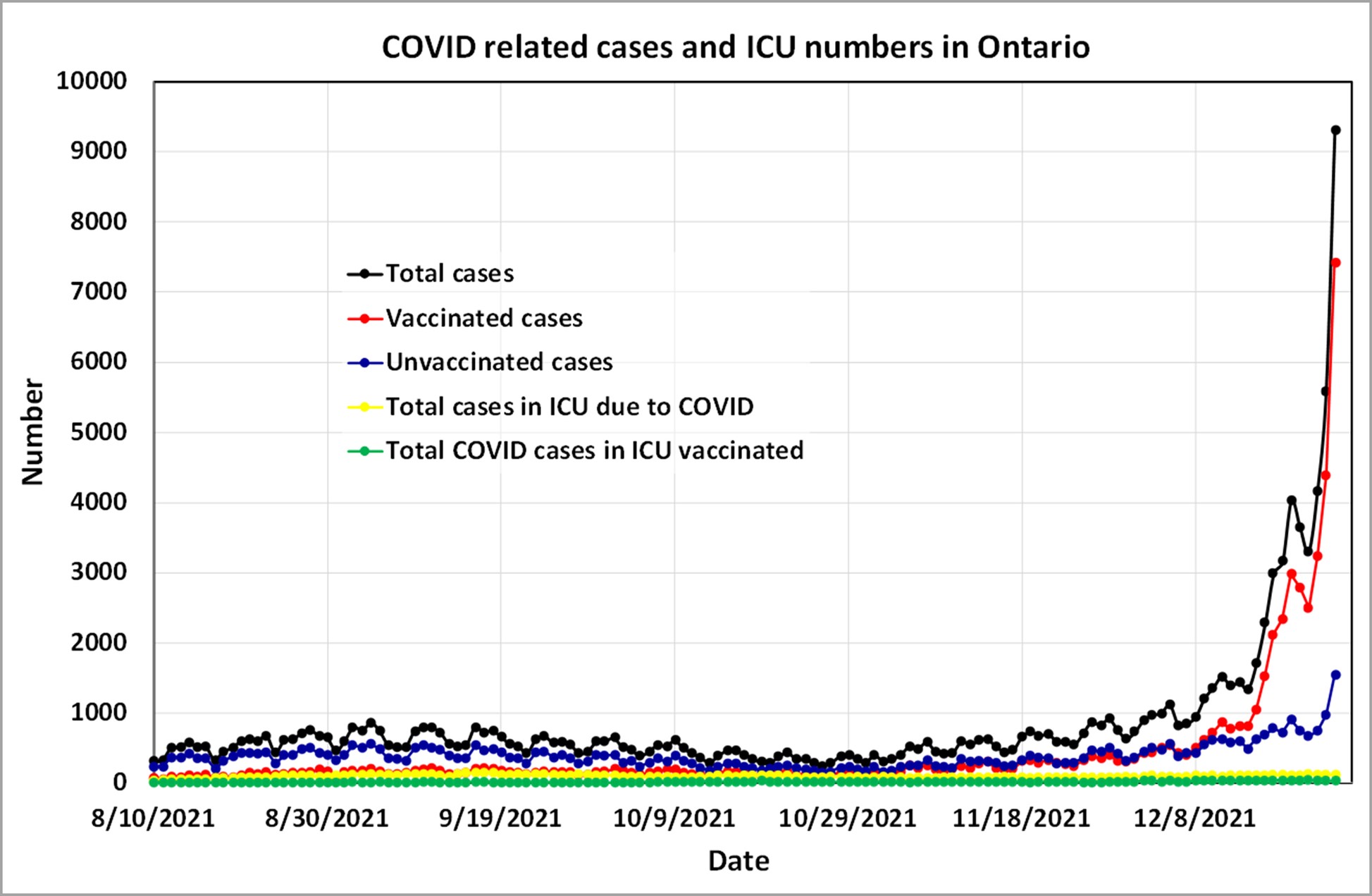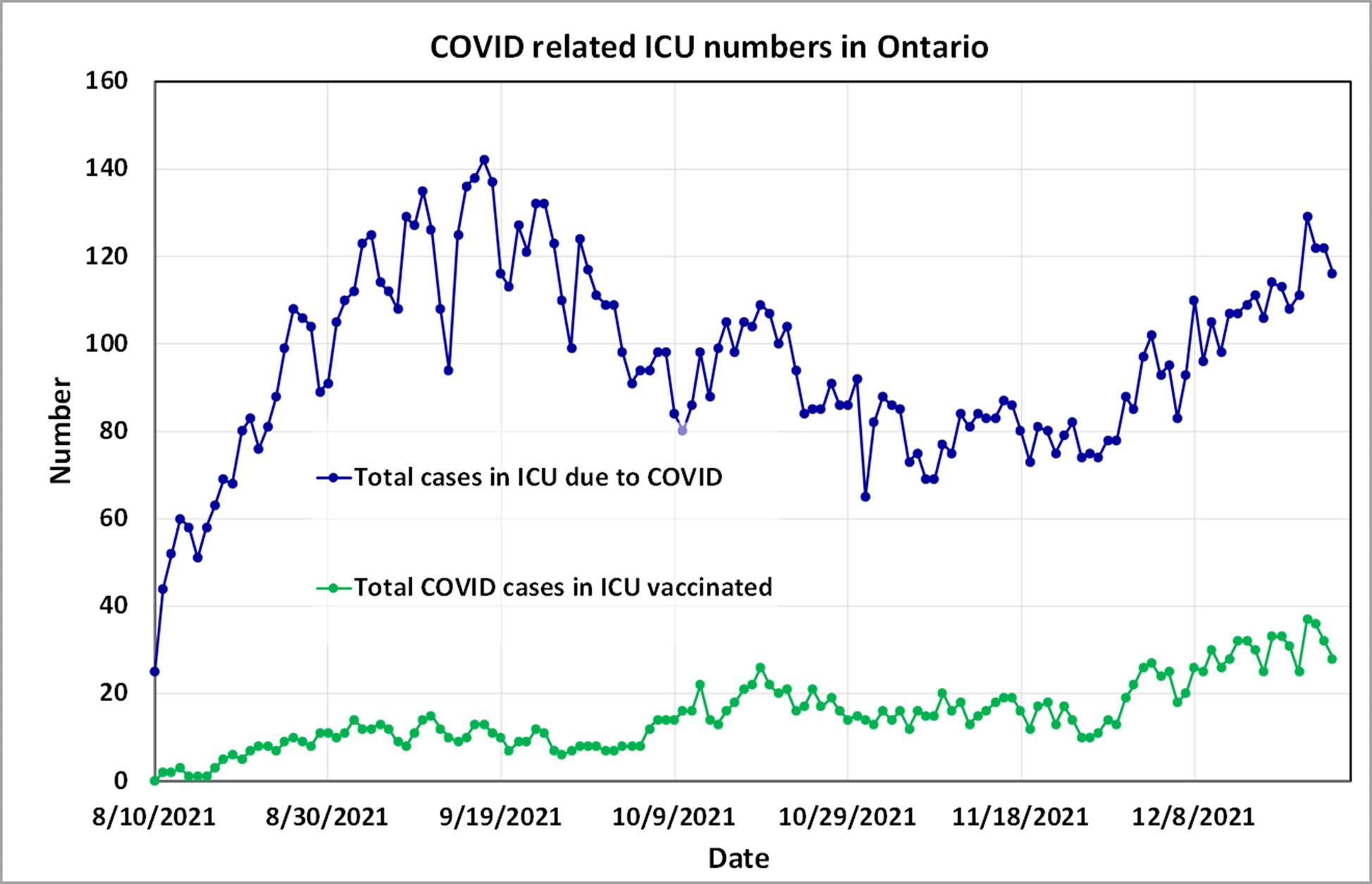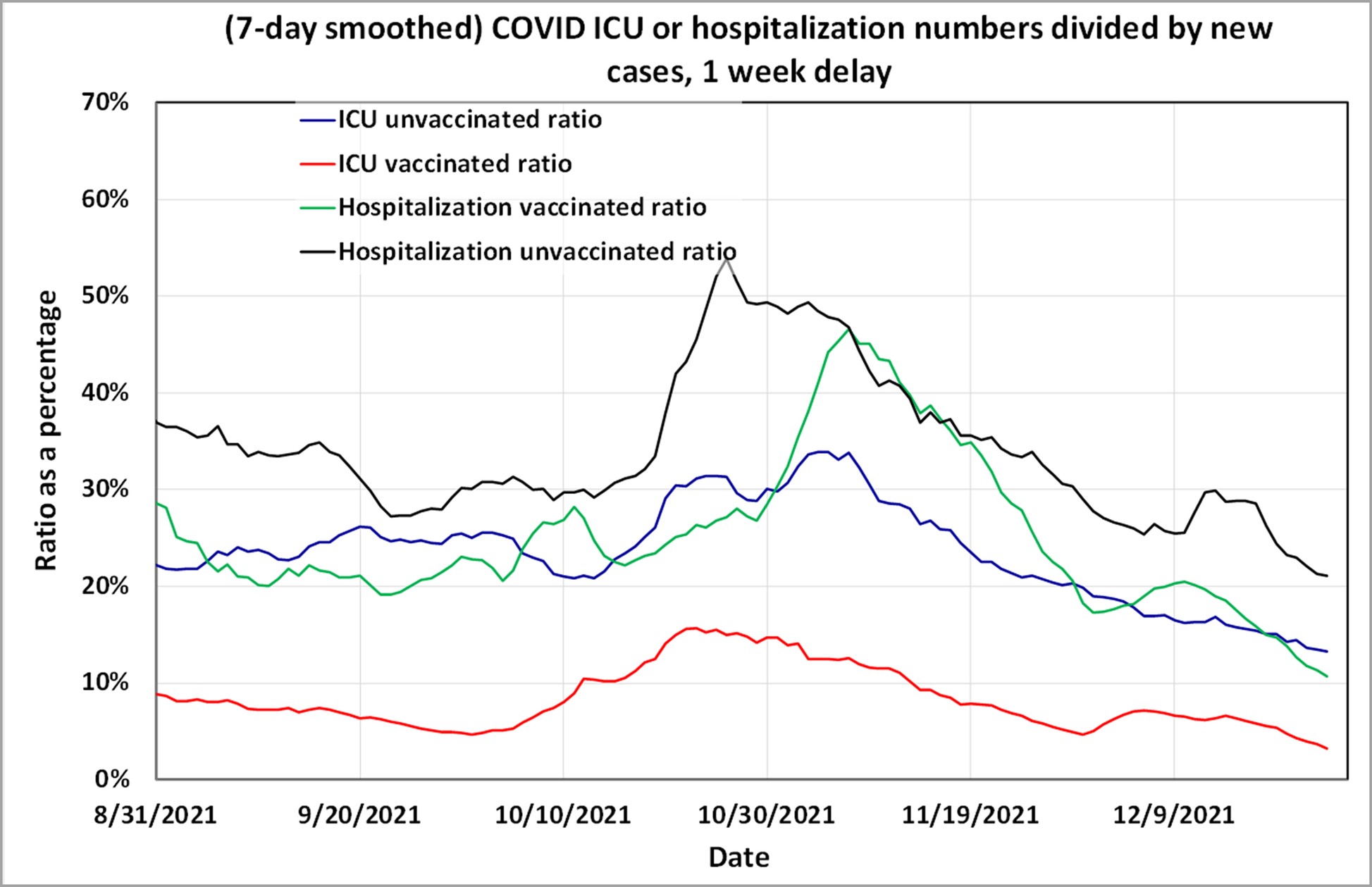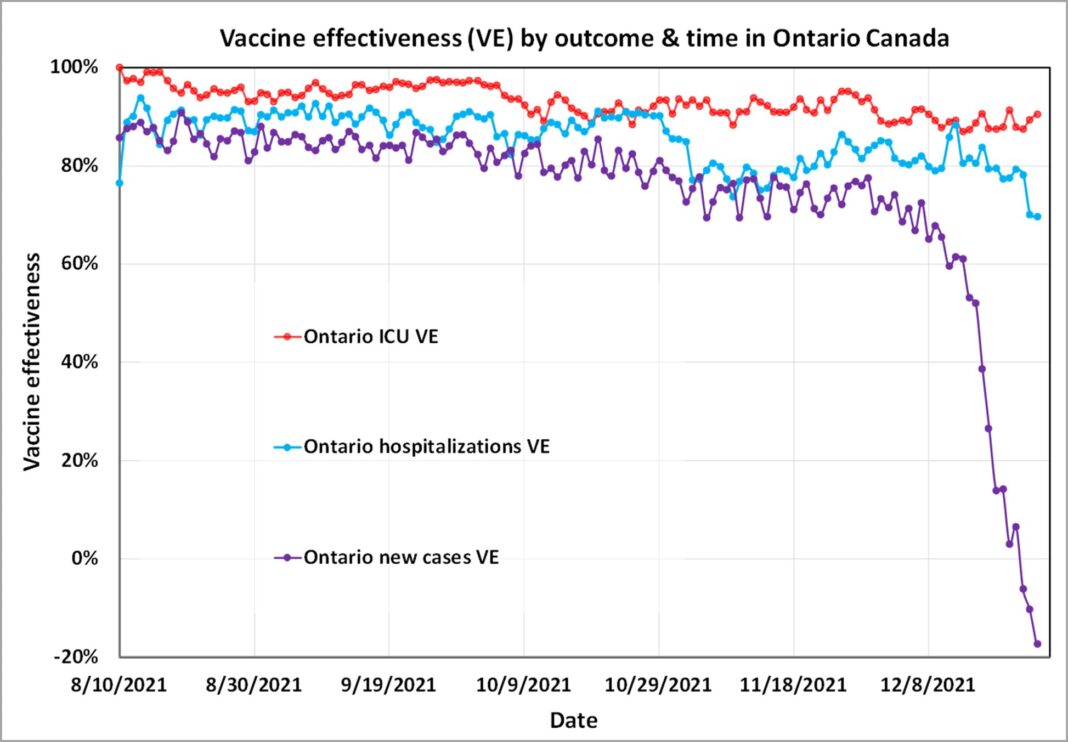Updated vaccine effectiveness in Ontario Canada, as of December 24, 2021, shows effectiveness against hospitalization and ICU hospitalization is holding between 70% and 90%, but against non-hospitalization, it has abruptly dropped below 0%.[1][2]
Reported COVID-19 cases have been rising dramatically in the United States and Canada over the past few weeks, with the U.S. showing 197,856 new cases and Canada 20,693 new cases on Dec. 23.[3][4]The CDC estimates that over 73% of new cases are caused by the new, highly transmittable Omicron variant.[5]
Ontario is thought to be the first province in Canada to exerience the surge from Omicron.[6] [4] It reported 9,317 cases, or 45% of all of Canada’s new cases on Dec. 24, making it a reasonable predictor of what other regions in North America might expect from Omicron.[7] [5] We first reported on the effect of Omicron in North America in this Dec. 20 article – Ontario vaccine effectiveness nosedives amid surge in new cases – which examined the effect of Omicron on vaccine effectiveness. We saw that the vaccine effectiveness against experiencing a new case of COVID had dropped precipitously to 14%, though the vaccine effectiveness against hospitalizations and ICU remained high, between 80 and 90%. The problem is that the hospitalization and ICU admission are trailing indicators, meaning they occur later, and given the recentness of the Omicron surge, we could not be sure that the vaccine effectiveness to severe outcomes was truly this high. Further, we could not predict what the strain on the health care system would be.
This article examines this question with new data.
Speculation on Omicron’s severity
Speculation on the severity of Omicron abounds. Omicron is thought to have developed first in South Africa, but that country has not yet experienced high strain on its medical system as measured by hospitalizations or deaths.[8]In congruence with this data, the U.K. Health Security Agency currently estimates that Omicron is 50-70% less likely to lead to hospitalization than the Delta variant.[9]Not everyone agrees with this optimistic assessment. Another study conducted in England could find no evidence to support the conclusion that Omicron is less severe than the Delta strain.[10]
There are limitations and weaknesses with each of these conclusions: the South African data is based on a younger population. The median age in South Africa is 27.3, which could be of material importance.[11]The contradictory conclusions out of the U.K. are based on data that suffers from a lack of sufficient history and completeness. Adding further complexity to any estimation of the true severity of the Omicron variant is the fact that the immunological response of the population is different now compared to earlier in the pandemic. Vaccinations and natural immunity will affect the impact of Omicron as it is compared with earlier variants.[12]Further, medical treatments of COVID have improved. Even when we have a better historical measure of Omicron’s severity, it may be difficult to determine the strain’s absolute severity because of these factors.
Rather than speculate further, let us look at the updated Ontario data, and see what it indicates. This new analysis must be taken in context, as it is still early in the game.
Updated vaccine effectiveness
The vaccine effectiveness data has been updated as of Dec. 24, and is charted above. Vaccine effectiveness to new cases has continued to drop, and on the last three days is negative. At the same time, vaccine effectiveness to severe outcomes has remained high, particularly for ICU admissions. The last two days showed a drop in the vaccine effectiveness to hospitalization. The vaccine effectiveness to severe outcomes likely still does not accurately reflect the effect of Omicron due to the time-delayed nature of severity. We will continue to monitor the data, and provide updates as the data gains integrity, and trends become more meaningful.
There is a contradiction in vaccine effectiveness between new cases and severe outcomes that may unravel with more history as the time delay becomes less of a factor.
Hospitalizations and ICU admissions
The case numbers – both non-severe and severe – should eventually be an indicator of Omicron’s impact on the health care system. The chart below outlines this for new cases and severe outcomes. New cases continue to rise sharply.

Updated case and ICU numbers in Ontario as of Dec. 24 show that case numbers among the vaccinated abruptly surged. ICU trends are difficult to see as they are relatively lower.[13][14]
Because the new case numbers are so high in comparison to ICU numbers, a separate chart that only includes ICU admissions is presented below. There has been a slight rise in ICU admissions, though it is moderate in comparison to the new case numbers.

Updated ICU numbers in Ontario as of Dec. 24 show that ICU admissions are rising moderately.[15][16]
Is Omicron less severe?
If severe outcomes remain low despite high case numbers, we will eventually conclude that Omicron has a relatively small effect on our health care systems. We can make a comparison ratio to this effect with the data we have now, though we must remember that we lack enough history to be definitive.
In the charts below, we create ratios for ICU admissions and hospitalizations for vaccinated and unvaccinated persons against the number of new cases. The ratios are consistent with vaccination status. Let us define them, for clarity:
- “Hospitalization unvaccinated ratio” is the ratio of the number of persons admitted to the hospital who are unvaccinated by the number of new cases that were unvaccinated, at a time lag.
- “Hospitalization vaccinated ratio” is the ratio of the number of persons admitted to the hospital who are vaccinated by the number of new cases that were vaccinated, at a time lag.
- “ICU unvaccinated ratio” is the ratio of the number of persons admitted to the ICU who are unvaccinated by the number of new cases that were unvaccinated, at a time lag.
- “ICU vaccinated ratio” is the ratio of the number of persons admitted to the ICU who are vaccinated by the number of new cases that were vaccinated, at a time lag.
Since severe outcomes lag the disease onset, we must apply a time delay between the new case numbers and the admission to the hospital or ICU. How long of a delay is there between symptom onset, hospitalization, and ICU admission? Studies conducted in England and Canada indicate that a delay window anywhere from one to 28 days is common, with one to two weeks being the most appropriate delay, statistically.[17][18]We, therefore, present the ratios in two separate charts, the first with a one-week delay, and the second with a two-week delay between new case numbers, and hospital or ICU admissions.
The charts both show that for those contracting COVID, the ones who are vaccinated have a lower relative chance of being admitted to the hospital or the ICU.
For the one-week time lag case, all ratios appear to be dropping, which would indicate a decrease in relative severity of COVID. The trends for the two-week time lag are less definitive. If Omicron is truly less severe, we would expect this downward trend to continue.

Ratio of the number of new cases being presented to admission to either the hospital or ICU. These ratios are consistent with vaccination status, and have a one-week delay between cases, and ether hospitalization or admission to the ICU. All ratios are dropping slightly.[19][20]

Ratio of the number of new cases being presented to admission to either the hospital or ICU. These ratios are consistent with vaccination status, and have a two-week delay between cases and ether hospitalization or admission to the ICU.[21][22]
Interpretation
We still do not know if Omicron is less severe, and how much additional strain it will put on the health care systems of North America. The data to date has elements that are both optimistic and pessimistic.
Optimistic
- The vaccine effectiveness remains high to severe outcomes such as hospitalizations and ICU stays.
- The ratio of severe outcomes to cases may be dropping.
Pessimistic
- The vaccine effectiveness to new cases has dropped to below zero.
- New case numbers are rising quickly.
Contradictory
- Vaccine effectiveness to new cases is dropping while the vaccine effectiveness to severe outcomes remains high. Vaccine effectiveness to hospitalization has started to drop, while vaccine effectiveness to ICU admission remains quite high. Why are these categories not showing congruent behaviour? Data in the weeks to come should tell us a lot as we get through the time lag between the surge in new cases and understanding the severity of infection.
The Christmas news is a mixed bag. It is too soon to know the true effect that Omicron will have. We will continue to monitor the system closely and calmly.
References
[1] COVID-19 Vaccine Data in Ontario, Ontario Government, December 24, 2021
[2] Hospitalizations, Ontario Government, December 18, 2021
[3] Worldometer, December 24, 2021, United States
[4] Government of Canada, December 23, 2021, COVID-19 daily epidemiology update
[5] Rattner, Nate, December 20, 2021, Omicron now the dominant U.S. Covid strain73% of cases, CDC data shows
[6] Lee, Michael, December 16, 2021, Ontario at ‘leading edge’ of Omicron: ER doctor, CTV News
[7] COVID-19 Vaccine Data in Ontario, Ontario Government, December 24, 2021
[8] Sguazzin, Antony, December 17, 2021, South Africa hospitalization rate plunges in Omicron wave, Toronto Sun
[9] Macdonald, Michael, December 23, 2021, Canada reports over 20k new COVID-19 cases amid record breaking Omicron Surge, Global News
[10] Ferguson, Neil, et al, December 16, 2021, Report 49-Growth, population distribution and immune escape of Omicron in England, Imperial College London
[11] Our World in Data, December 24, 2021, South Africa: Coronavirus Pandemic Country Profile
[12] Haridy, Rich, December 19, 2021, UK finds Omicron spreading fast, “no evidence” it’s milder than Delta, New Atlas
[13] COVID-19 Vaccine Data in Ontario, Ontario Government, December 24, 2021
[14] Hospitalizations, Ontario Government, December 18, 2021
[15] COVID-19 Vaccine Data in Ontario, Ontario Government, December 24, 2021
[16] Hospitalizations, Ontario Government, December 18, 2021
[17] Tuite, Ashleigh, et al, March 29, 2021, COVID-19 Hospitalizations, ICU Admissions and Deaths Associated with the New Variants of Concern, Science Table COVID-19 Advisory for Ontario
[18] Sutherland, Esther, et al, June 29, 2021, Coronavirus (COVID-19) Infection Survey technical article: waves and lags of COVID-19 in England, June 2021, Office for national Statistics
[19] COVID-19 Vaccine Data in Ontario, Ontario Government, December 24, 2021
[20] Hospitalizations, Ontario Government, December 18, 2021
[21] COVID-19 Vaccine Data in Ontario, Ontario Government, December 24, 2021
[22] Hospitalizations, Ontario Government, December 18, 2021
(Lee Hunt – BIG Media Ltd., 2021)


